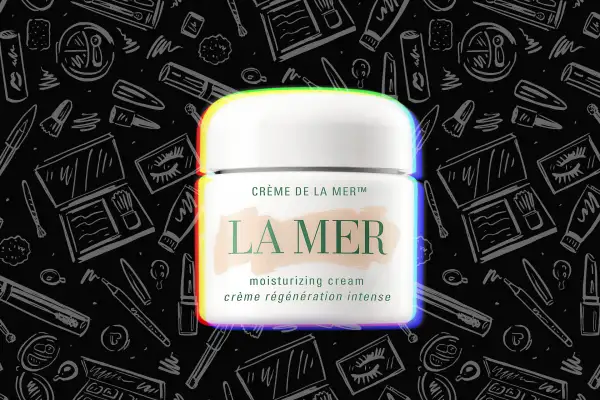La Mer Cream Costs $345 for a Tiny Jar. Could It Possibly Be Worth the Money?

Few industries are as steeped in mythology, or have more followers willing to believe in it, than skincare.
A popular $135 anti-aging oil made with honey sourced from the French island of Ouessant allegedly sells a new bottle every 26 seconds. Saks Fifth Avenue carries a $95 exfoliant formulated with “quartz crystals” that can “remove impurities” from your skin. Mosey over to Sephora.com, and you’ll find thousands of miracle elixirs that promise to fix what ails you (wrinkles, dull skin, acne) through the healing properties of things like “virgin marula seed,” “kombucha essence” and so on.
But of all the products vying for a spot in our medicine cabinet, La Mer’s “Crème de la Mer” is maybe the most enduring.
The infamous moisturizer has an origin story that puts most marketing copy to shame: Founder Dr. Max Huber was an astrophysicist who, legend has it, spent 12 years and 6,000 experiments formulating what would become La Mer’s signature product after a 1950s’ lab accident badly burned his skin.
Its price tag is even more legendary: Depending on where you shop, a 2-ounce jar of the stuff (roughly the size of a small spice container) might set you back an eye-popping $345; a 16.5-ounce jar costs close to $2,500.
All these years later, devotees are more than happy to part with that kind of cash: La Mer saw double-digit sales growth at the end of 2020, according to an earnings report from parent company Estee Lauder. In February 2021, an anonymous Women’s Wear Daily panel named Crème de la Mer the second greatest skincare product of all time. (Representatives from Estee Lauder did not respond to Money’s request for comment.)
Is the hype driven by a bunch of skincare snobs throwing their money into the wind? Or is Crème de la Mer actually worth it?
We tapped two industry veterans to figure that out.
What is Crème de la Mer made of?
Like most skincare products, the ingredient list that makes up La Mer’s signature moisturizer is … lengthy. But the first few are the most important, since U.S. law requires cosmetic ingredients to appear in the order of their concentration, says Dr. Aegean Chan, a California-based dermatologist who specializes in the efficacy of popular skincare products.
Crème de la Mer’s first listed ingredient is “algae (seaweed) extract,” followed by mineral oil, petrolatum (petroleum jelly), glycerin and a bunch of sciencey-sounding ingredients like “isohexadecane” and “microcrystalline wax.” Essential oils like sesame seed and eucalyptus appear further down the list, and perfume tops it off.
La Mer calls this proprietary mix its “Miracle Broth,” which, according to the website, goes through a three- to four-month fermentation process that involves something called “light and sound energy” to “enhance the energy” of the ingredients (you can read more about that here).
La Mer’s website also nods to the “lime tea … derived from hand peeled limes that undergo a careful extraction process” in every bottle. It’s worth noting, though, that the only mention of lime in the ingredient list, “lime extract,” clocks in at number eight — meaning there are seven ingredients with higher concentrations in Crème de la Mer’s formula.
Why is La Mer so expensive?
The website description for La Mer’s signature product uses the phrase “radiant transformation” to describe what pretty much any drugstore moisturizer can do: “heal dryness,” make your skin ”soft to the touch” and wrinkles less noticeable.
Still, some people swear by it. And not just any people: Famous people. Ana De Armas, Chrissy Tiegen, Blake Lively and a laundry list of other celebrities who get paid to have covetable skin swear by La Mer — or at least say they do.
Underpinning the allure is some good ol’ fashion corporate proselytizing about the “legendary healing powers,” found in the sea kelp it harvests from “pristine waters off of Vancouver Island.”
Chan says there’s “really not any strong scientific evidence to show that seaweed has magical properties.” After all, it’s found in a lot of regular household items, food products and over-the-counter pharmaceuticals. And while a few in vitro studies have shown that seaweed does have some antioxidant properties, there’s no indication that those results can be generalized outside of a lab environment, or on human skin.
Above all, there's no obvious correlation between the cost of La Mer's ingredients and its extraordinarily high price tag. In fact, a 2019 Business Insider investigation claims that a medium-sized bottle (3.4 ounce) of Crème de la Mer only costs about $35 to make.
What are the best La Mer alternatives?
Maybe the only skincare discourse that gets as heated as La Mer hype is La Mer hate — and what cheaper imitation products will work as a stand-in.
Whenever you’re shopping for skincare products, it’s important to keep shelf life in mind, says Claire McCormack, a longtime beauty journalist and an editor at Beauty Independent.
Expiration dates can’t always be trusted, she says. Even if a tub of moisturizer says it’s good for a year after you open it, the truth is, “the product starts degrading as soon as it leaves the factory.”
Skincare products that are manufactured by big companies tend to be made in large batches, and can end up sitting on retail shelves for months or longer, McCormack says. If you want to invest in a luxury moisturizer, McCormack recommends going with a smaller, independent brand that’s likely to have better command of its supply chain and quality control strategy. Her recommendation? Blue Cocoon from May Lindstrom Skin; a product McCormack calls a “moisturizing bomb” that can only be bought on the company’s website. A 1.7-ounce jar of Blue Cocoon will run you $180, half the cost of a 2-ounce tub of Creme de La Mer.
Dr. Aegan Chan notes that outside of algae extract, the main ingredients in Crème de la Mer are basic things like glycerin and mineral oil, which are in most facial moisturizers. Some of the most referenced La Mer dupes are products many of us have tucked in our bathroom cupboards already: Nivea Creme ($3.97), Aquaphor($14) and plain ol’ Vaseline ($4.00) — all of which “would probably give you a very similar moisturizing effect … at a fraction of the cost,” Chan says.
Is La Mer worth the price?
Crème de la Mer comes with a whole ritual: You open the jar, dip a finger in, warm it in your hand, and press (not rub!) it into your face. It’s a luxurious experience (this is Ana De Armas’ moisturizer we’re talking about), and for skincare obsessives who aren’t satisfied with slapping on a layer of Vaseline and calling it a “routine,” that alone might make it worth the cost.
That was certainly true when McCormack bought her first jar.
“I was in my 20s,” she says. “I didn’t have kids and a house and a car, so I had a little more disposable income, and there was so much buzz around it. It felt really special to me then.”
McCormack loved the way Crème de la Mer made her skin look — dewy as all hell — and how fancy using it made her feel. To make the cream last, McCormack says, she’d mist her face with water so she could spread it easily, and would only have to use a little at a time.
In the years since, she’s found lots of other products that give her that same glow, none of which cost as much as a cross-country plane ticket. (One recent fave: a line of sheet masks from 111Skin that start at $15.)
“La Mer is iconic, there’s no doubt about it,” she says. “Is it worth the money? I’m going to say it’s not.”
Chan agrees.
“If you really love La Mer, and using it makes you feel like a whole human, that’s totally valid,” she says. But don’t buy into the idea that a product is special just because it’s expensive.
“A lot of messaging around skincare and marketing wants you to feel like you need it, that there’s no other product that could possibly provide these benefits, and that’s blatantly not true,” she says.
Her take on Crème de la Mer?
“I do not think it’s worth the price tag.”
More from Money:
How to Lock in a Super Cheap Travel Deal Without Getting Scammed
Are Cash-Back Apps like Rakuten Actually Worth It?
